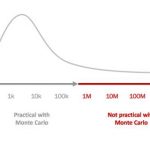ARM’s Azeez Bhavnagarwala recently gave a talk hosted by Solido on the benefits of variation aware design in optimizing 6T bit cells. Azeez sees higher clock rates, increasing usage of SRAM per processor and the escalating number of processors, shown in the diagram below, as trends that push designers toward 6T. Six Transistor… Read More
Tag: solido
Solido Saves Silicon with Six Sigma Simulation
When pushing the boundaries of power and performance in leading edge memory designs, yield is always an issue. The only way to ensure that memory chips will yield is through aggressive simulation, especially at process corners to predict the effects of variation. In a recent video posted on the Solido website, John Barth of Invecas… Read More
TSMC Update at #53DAC!
TSMC is having an interesting year for sure. I was at the TSMC Symposium in Hsinchu last week and everyone was talking about the new 16FFC process. Silicon is out and it is exceeding expectations leading some people (me included) to believe that TSMC 16FFC will be the next TSMC 28nm in regards to popularity. To be clear, 16FFC is currently… Read More
How TSMC Tackles Variation at Advanced Nodes
The design community is always hungry for high-performance, low-power, and low-cost devices. There is emergence of FinFET and FDSOI technologies at ultra-low process nodes to provide high-performance and low-power requirements at lower die-size. However, these advanced process nodes are prone to new sources of variation.… Read More
TSMC and Solido on Variation-Aware Design of Memory and Standard Cell at Advanced Process Nodes
Being that TSMC and Solido are founding members of SemiWiki, you should be able find out everything you ever wanted to know on their respective landing pages. If not, just ask a question in the SemiWiki forum and I can assure you it will be answered in great detail. And here are some other interesting 2015 factoids from Solido:… Read More
Variation Aware FinFETs are Critical!
As I mentioned in “EDA Dead Pool” acquisitions in our industry will continue at a rapid pace. The latest victim is 10 year old French company Infiniscale who was recently purchased by Silvaco. This was more of a “let’s put your product through our massive sales and support channel” kind of deal so it will be 1 + 1 = 3 accretive for sure.… Read More
Moving with Purpose for Certainty
In 1492 Christopher Columbus sailed from Spain towards west on Atlantic Ocean in search of Asia and Indies. Between his four voyages (1492 – 1502) he discovered many different islands and then what we call Americas. Although he had a compass with him, imagine searching a needle in a haystack. Even with localization of areas and then… Read More
Solidly Across the Chasm
Last week I wrote about EDA companies crossing the chasm, with Jim Hogan (who needs no introduction) and Amit Gupta, CEO of Solido. So how did those rules work out for Solido?
See also Getting EDA Across the Chasm: 15 Rules Before and 5 After
The founding team of Solido:
- discovered process variation for analog was a problem as companies
Getting EDA Across the Chasm: 15 Rules Before and 5 After
Crossing the Chasm by Geoffrey Moore (not that G. Moore!) is one of the most well known books on high technology marketing. When I worked at VaST, Mohr Davidow Ventures (MDV) invested in us and Moore (not Mohr), who was a partner there, spent an afternoon with us brainstorming what it would take for us to cross the chasm. Coincidentally,… Read More
Replacing the British Museum Algorithm
In principle, one way to address variation is to do simulations at lots of PVT corners. In practice, most of this simulation is wasted since it adds no new information, and even so, important corners will get missed. This is what Sifuei Ku of Microsemi calls the British Museum Algorithm. You walk everywhere. And if you don’t walk to… Read More










